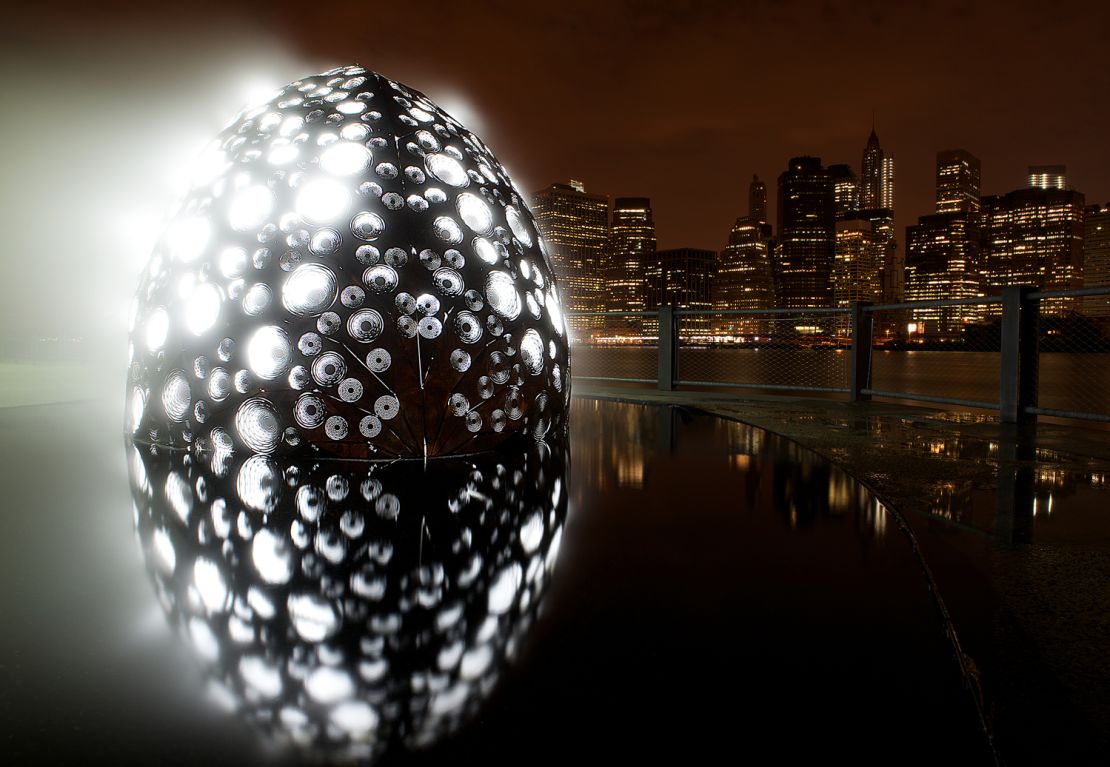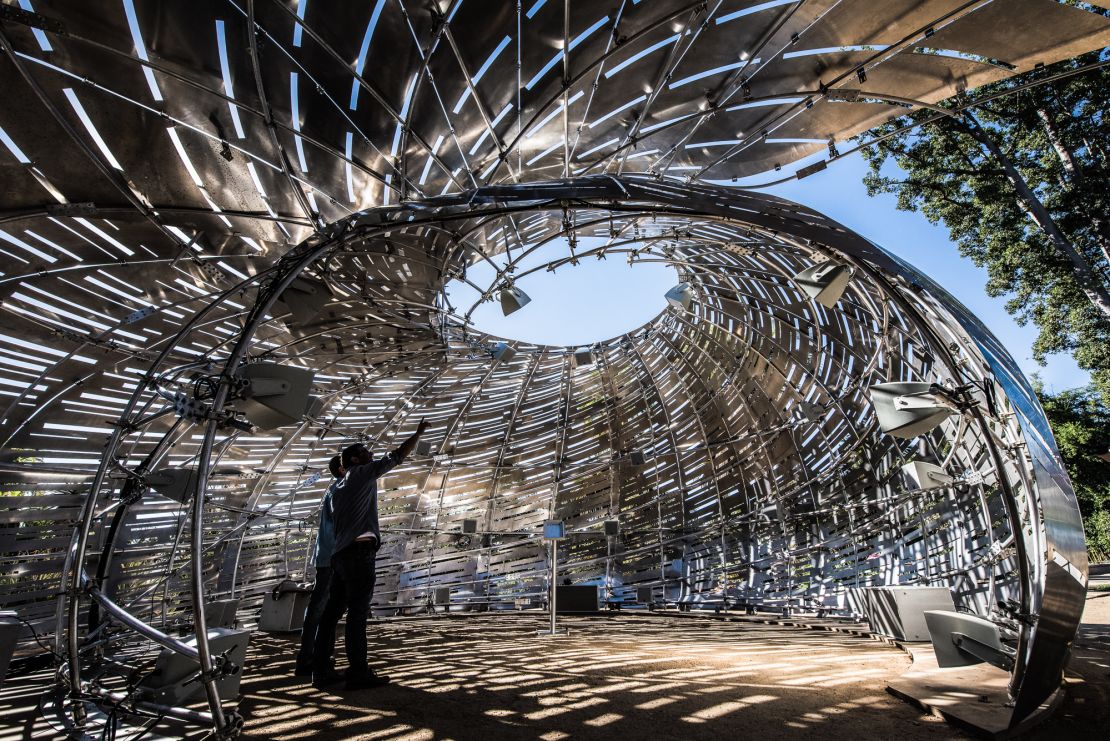NASA’S Jet Propulsion Laboratory (JPL), a cluster of concrete 1970s-style buildings nestled among the San Gabriel Mountains in Pasadena, is the birthplace of some of humanity’s most astounding achievements.
The first US mission to the moon, the Mars rover, the first scientific satellites in orbit – for decades JPL scientists have been looking outward, pushing the boundaries of human knowledge beyond our planet.
It’s awe-inspiring, imagination-tickling work. But space scientists spend their days focused on the numbers, data and details. So at JPL, a team of wonder-cultivators stands guard against the mundane. Embedded on campus, it is composed of artists and designers tucked among the laboratory’s astrophysicists, aerospace engineers and geologists. They call themselves The Studio.
The Studio functions as an in-house creative agency of sorts. Its clients are scientists, missions and JPL departments who approach the team with their creative needs.
So far the Studio has created a human-scale comet in Brooklyn and an interactive installation that simulates exploring the surface of Jupiter. It has helped scientists to visualize countless missions and projects, from landing a spacecraft on a comet to designing a disaster-response robot.
Inside The Studio

The Studio began with Dan Goods. Upon graduating from the ArtCenter College of Design in Pasadena, Goods knew he wanted to apply his design skills to science. He sent his resume out to different research labs in the area but nobody knew what to do with him.
Finally, Anthony Freeman, who managed JPL’s Mission and Systems Architecture section, told him, “I don’t really understand what it is that you do, but I’ll give you six months.” That was almost 15 years ago.
Read: Hate your job? NASA wants you to work on Mars
One of Goods’ first projects was a brightly lit wall which reveals planets and other shapes when shadows are cast on it. The installation was designed to capture the challenge – and reward – of searching for new planets.
After the success of his early projects, Goods was able to hire his “creative soul mate” David Delgado, a classmate from the ArtCenter College of Design. Then, seven years ago, he brought on product designer Jessie Kawata. The Studio at JPL was born.
The actual studio from which the team works is an unassuming gray trailer. But open the door and it’s obvious you’re in a place where extraordinary things happen. Posters, whiteboards, photographs and sketches cover the walls. Tables are littered with old scientific glassware, a lumpy black model of some space rock, a copy of “The NASA Atlas of the Solar System” and various other curiosities.
In addition to Goods, Delgado and Kawata, the team now includes graphic designer Lois Kim, artist Joby Harris, formerly of Disney’s research and development arm, Walt Disney Imagineering, and illustrator Liz B. De La Torre, also from the entertainment world.
De La Torre and Kim spend a lot of their time creating storyboards for mission proposal books, which create visual aids for mission planners and can be the length of a short novel. De La Torre worked on the 2004 launch of the Rosetta, the first probe to land on a comet, by using Hollywood filmmaking and matte painting technique to visualize the operation.
NASA lures would-be space travelers with awesome tourism posters
As she quizzed the scientists, helping her create the visuals, it prompted them to ask questions about the comet’s surface that they hadn’t fully considered. Would there be geysers or caves? What was the surface like? They knew it was porous, but not like a sponge. They described at as more like “pancakes cooking,” De La Torre recalls.
“So I went and literally made pancakes, and took photos of the texture,” she says. “It actually ended up being pretty accurate when [the probe] arrived.”
The Studio’s reach extends far beyond the JPL campus. While its role is primarily to assist JPL’s missions, it also exists to tell the laboratory’s stories to the public.
This mostly happens through immersive installations. In 2014, Delgado and Goods collaborated with Studio KCA, a New York architecture and design firm, on the “Metamorphosis,” a model of a comet in Brooklyn – complete with a realistic tail of water vapor – celebrating the Rosetta’s decade-long mission.
The steel sculpture, which is about nine feet tall and 12 feet long, glows to mimic how real comets reflect the sun’s light. Shoots of vapor combine with dust to create the comet’s tail.
Read: NASA lures space travelers with free posters
In 2015, the Studio commissioned Studio KCA once more to design a “sound experience” called Orbit Pavilion in which visitors enter a huge model of a seashell. Inside, trajectory data of NASA satellites is paired with sounds that move across the inside of the shell producing an effect similar to that of jets flying overhead.
Delgado and Goods came up with the idea for Orbit Pavilion at NASA’s Goldstone Deep Space Communications Complex, a California observatory that communicates with spacecraft orbiting the Earth and those in the far reaches of our solar system.
“You get out (to the complex) and there’s this issue of perception, because you know that there’s a huge amount of dataflow going back and forth. But it’s just perfectly quiet and you have no idea what is happening,” Delgado says. This led the pair to think, “What if you could listen to where these spacecraft are?”

But one of the Studio’s most affecting works is one of its smallest: a hole drilled into a grain of sand. The grain was supposed to represent the Milky Way, while the hole symbolized the area of our galaxy in which our planet – and planets around other stars – are found.
After Goods displayed the project under a microscope, he recalls an astrophysicist coming to take a look.
“This guy gets to point Hubble at things,” Goods says. “He looked down (at the sand), he looked up and he looked in my eyes and said ‘You reminded me why I work here.’”
The Studio team’s position is a rare one. Very few research institutions have such a robust art and design facility. But even amid uncertain government funding for scientific research, the JPL continues to stand behind the Studio’s essential role at the lab.
Read: How depictions of aliens have evolved
“We recognize the value of communicating, both externally to tell the story, and internally to help with the missions,” says JPL’s deputy director, Lieutenant General Larry James.
“I think one of the key things about JPL is that we have such an incredible story to communicate. When you look at all the amazing missions – to Mars, to Saturn, to Jupiter, humanity’s first interstellar spacecraft with Voyager – you want to communicate that well. You want to communicate that uniquely to the public, and (the Studio) absolutely help us do that.”
“JPL is all about being on the edge of possibility,” Goods says.
And that’s where the Studio is firmly ensconced: on the border of what has been done, and what’s never even been imagined – until they imagine it first.



























